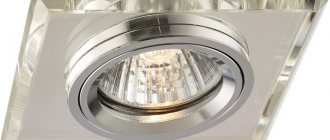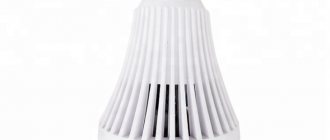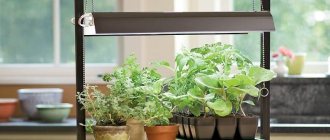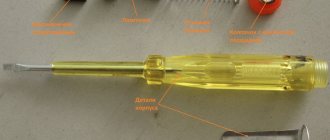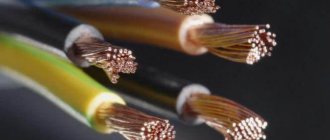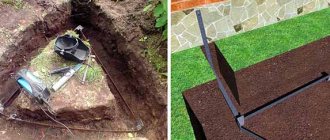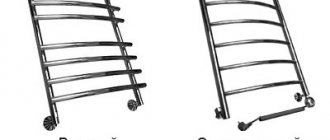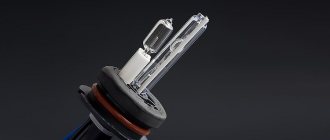↑ What are the requirements for lighting systems
Every gardener knows that young plants need natural light for further harmonious development. But in most regions of Russia, solar lighting in the first three to four months from the beginning of the year is not enough for the full development of shoots. The weather is mostly cloudy, especially in those months when sowing seeds for seedlings begins.
If plants do not have enough ultraviolet radiation, this leads to withering of shoots and leaves. The seeds do not hatch for a long time, the sprouts that appear are thin and lifeless, the leaves are pale green. You have to use artificial lighting to help the sprouts. There are requirements for lighting devices installed near seedlings:
- the light spectrum should be blue or red;
- the required lamp power is selected;
- choose the desired form;
- a minimum amount of heat should be generated from the light source;
- phytolamp must be energy efficient and reliable.
When lighting is used wisely, it brings great benefits not only to seedlings, but also to adult plants.
It is worth listening to the advice of experienced flower growers and gardeners if you decide to grow seedlings yourself:
- As soon as the seedlings appear, they become the object of close attention. When the shoots are thin and try to reach for natural light, they bend or begin to droop, they don’t get enough sunlight.
- Various lamps are available, including high power ones. This is bad for plants: the leaves begin to turn yellow, or yellow spots appear on their green background. It is easy to understand that a lamp has strong power. It is enough to place your palm at the height of the seedlings. If your hand becomes hot within 20-30 seconds, then the plants feel the same. Therefore, fix the phytolamp higher and again check the comfort for the seedlings on your hand.
- Containers with planted seeds are illuminated around the clock. With the emergence of seedlings, the lamp is turned on for a certain time. This time is calculated based on the fact that the sprouts need light for 12-15 hours.
- When the sun is shining outside the window, the phytolamps are turned off. After all, the plants will have enough heat and sunlight.
- And in the case when containers with seedlings are installed on window sills facing south, additional lighting is required. After all, in the winter months and in March the weather does not please us with sunny days.
- The lamp is fixed at a distance of 10-15 cm from the plantings. This value depends on the intensity of the light flux and the power of the lamp.
Excess or lack of ultraviolet radiation can be seen by wilting of leaves, the appearance of spots, curling of leaves and stopping the growth of seedlings.
How and why to use
Photosynthesis plays a vital role in the life of all flora. The process helps produce oxygen for the seedlings to breathe and ensures the production of organic substances necessary for plant nutrition. Photosynthesis occurs under the influence of solar energy. When there is not enough natural light, the green pet is deprived of nutrition, begins to wither and shed leaves
Why ordinary lamps are not suitable for plants
the extracting element - the sun's rays - in the process of photosynthesis.
Install the products above pots with seedlings, simulating natural light. It is necessary to turn on the light bulbs regularly, the duration of daylight hours
Installation of a phytolamp
sthenia.
Principle of operation
The features of the device are influenced by the type of product, but in general the principle of operation is the same for all varieties. Seedling bulbs produce photons in a narrow range of colors that mimic the energy of the sun's rays. Most models emit a blue or red glow. The first helps the growth of leaves and the development of the root system, the second stimulates flowering.
The most effective spectrum for plant growth is blue and red in the range of 450 and 660 nm
In addition to participating in the process of photosynthesis, such lighting reduces the level of nitrates in green plants, disinfects the soil and accelerates the ripening of fruits.
In universal full spectrum light bulbs, blue and red are combined with white, but predominate. To human eyes their light seems
↑ How to choose the type of light source
A low-pressure lighting device, which is a gas-discharge fluorescent mercury lamp, was created for artificial lighting of green spaces. The phytolamp provides seedlings (and adult plants) with electromagnetic light, partially or completely in those areas of the spectrum (red and blue) that plants need.
↑ Incandescent lamp
Phytolamps emit light that is as close as possible to natural rays of light, which is important for plants. If we consider incandescent lamps, they are not suitable for supplementary illumination of seedlings due to low results. Conventional light bulbs illuminate the space with yellow and green spectrum. But they do not affect vegetative processes in any way. But the seedlings are heated too much, causing only harm, not benefit. In addition, incandescent lamps are ineffective, they have a short service life and consume a lot of electrical energy.
↑ Luminescent
When growing seedlings, many summer residents use fluorescent lamps. Among the advantages, we note their low price and economy. These phytolamps do not burn the seedlings, as they do not emit heat. The lamps satisfy the needs of seedlings in the blue spectrum. But the red spectrum of the lamps is emitted in the wrong range, and in small quantities. Among the disadvantages, we note the following points: the lamps are short-lived, take too long to light, their power is low, they have a bad effect on the organs of vision, as they flicker.
↑ Energy saving
Energy-saving phytolamps are a type of fluorescent lamps. They are used for additional illumination of individual adult plants. The light bulb can even be inserted into a regular table lamp. Energy-saving lamps emit little heat, so the seedlings are not burned. Among the advantages, we note a long service life and low energy consumption.
↑ Sodium
The gas-discharge environment inside the lamp is created using sodium vapor, which allows it to glow red-orange. These phytolamps are most often used in huge greenhouses. They are not suitable for home use. Among the advantages of sodium lamps, their durability and good light output should be noted. Why aren't they used at home? They are too high wattage, they will burn the plants, and the light from sodium lamps is harmful to the eyes. It is very difficult to focus the flow of light, and a lot of energy goes nowhere. Sodium phytolamps glow in the red spectrum, but cannot satisfy the needs of plants in the blue spectrum. Such lamps take a long time to turn on, their cost is high and, moreover, they are difficult to recycle.
↑ LED
Let us immediately note that LED phytolamps have no disadvantages, so they are the future. The lamps emit exactly the light spectrum that is important for seedlings at each stage of development. The spectrum changes at any given time. To do this, it is enough to replace some LEDs with others.
LED phytolamps have low heat output. Their lighting does not harm plants. Lamps are energy-efficient and economical light sources. Consumes 70% less energy than incandescent lamps.
One of the advantages is their reliability: even with “jumping” voltage, the lamps do not break. The service life reaches 50 thousand hours. LED lamps do not harm the health of either humans or plants. No special conditions are required for their disposal.
These phytolamps are convenient and compact to use - a light bulb with an E27 socket is screwed into a table lamp.
Of course, there is a minus - the price. But those who plan to grow seedlings for many years should purchase an LED lamp. It will pay for itself quickly.
Also, due to the development of technology, LED lighting is gaining its popularity at a rapid pace. Therefore, prices for phytolamps will also decrease.
Types and characteristics
It would seem like just a lamp, but there can be a great variety of different characteristics indicated on its packaging. And you should take a close look at each such inscription, otherwise the purchase will be useless. So, the box may indicate:
- Service life (shelf life)
- Power indicators (the spread here is very large: from twenty to three hundred watts)
- Color temperature characteristic
- How economical is the device?
- Light flow
The last indicator is key. It should become your main guideline. With it, you will understand how much light is coming from each direction. When you are looking at a device not for a greenhouse, but for an apartment, then, of course, external features will play an important role. Don’t get too carried away with design; a beautiful shape won’t help matters.
But the method of fastening is important. This may be a stationary object that needs to be installed in one place and secured. Or there is a variation of the hanging type. This structure can be moved if necessary. Today, several types of such devices are known:
1. Luminescent. Their color is lilac. Those. It turns out that there is an abundance of blue spectrum here, but very little red. Such conditions are just right for picky sprouts. Vegetables and herbs can still put up with such a neighborhood. More capricious ones require different characteristics.
Not very useful for the human eye. Viewing such a picture for a long time may even cause a migraine. You won’t have to spend a lot on them, but their service life leaves much to be desired. Plus, the light intensity here is modest, so you often have to take paired ones. In the cold you won't have any problems with them; they may simply not turn on.
2. Induction. This subspecies of the lamps described above is more advanced. After all, it does not contain electrodes, which means that nothing will burn out over time.
3. LED. They are definitely a favorite among their competitors. These small components allow you to assemble the perfect device from them. It will include both bluish and reddish light rays at once. Moreover, they will all be in the ideal spectrum. And these are 450 and 660 nanometers.
By the way, the LED phytolamp for plants is suitable for absolutely all types of greenery. Another “pro” of this choice is the lack of heating. Here you can get a maximum heating of up to sixty degrees. While other varieties heat up to temperatures seven times higher.
Not only will this protect the plants from overheating, but it will also prevent the soil from drying out too quickly, which means the number of waterings will be reduced. The cost of such an acquisition, of course, will not please you.
But it is durable - the service life can be extended to as much as one hundred thousand hours. In addition, an LED phytolamp for plants will save your budget, because it shines clearly on the target without wasting energy.
4. Energy saving. You won't be able to get by with one-time expenses. Over time, a change in spectrum will be required. They are often criticized for their lack of power. But you don’t need to buy a special frame for such a light bulb; you can find an old lamp at home and insert it there. Such proximity does not threaten plants with burns.
5. Sodium. Very bright. This is both bad and good at the same time. The good thing is that there is definitely enough light for the plants, but the bad thing is that this intensity is too strong for people, and a person cannot be in a room with such light without eye strain.
This device will not heat the air, but it will heat up itself, to such an extent that the smallest drop of water on its surface can lead to a mini-explosion. This means that we shouldn’t touch it while working. For the product to work at full capacity, you need to wait about ten minutes after connecting it to the network.
Its light beam will not hit the target exactly. It will spread throughout the area. One of the advantages is that they are “non-gluttonous” and durable. To ensure that the light goes where it needs to go, such devices have built-in mirrors.
These can be plates based on aluminum, or using silver alloys. Among the components of the “luminary” there is also mercury, so simply throwing it in the trash after use will not work.
6. Metal-halogen. They don’t have an exorbitant price, but problems may arise with the light intensity over time, because the device loses it. Although initially it can produce very good performance.
↑ What spectrum is important for seedlings
If you think that plants need any artificial light, then you are mistaken. Your plantings need light that has a certain spectrum. For example, the spectrum of green and yellow colors brings neither benefit nor harm to plants. But the spectrum is blue and red - they are vital for seedlings. Moreover, there should be many times more LEDs in the red spectrum.
The blue spectrum promotes seed germination, it stimulates the development of roots, and participates in the formation of a strong stem. The red spectrum is important when plants form flower ovaries, when flowering occurs and fruits begin to develop. The full growth of seedlings is influenced by the harmonious combination of the red and blue spectrum.
But not all blue and red spectra will be useful. For full photosynthesis, waves of a certain length are needed: for the blue spectrum it is 440-460 nm, for the red spectrum it is 640-660 nm. Lamp manufacturers indicate these values on the packaging. It is worth paying attention to the numbers; if they deviate in one direction or another, you should not buy such a phytolamp.
There are lamps with the addition of a white LED. This light does not irritate people’s eyes and the lamps can be installed in residential areas.
We recommend studying: this is how clematis is grown from seeds abroad - the results will surprise you!
How to choose the right one
If you think that when standing in front of a counter with such a product, you need to be guided only by the values on the price tags, then you are very mistaken. Everything is much more complicated here. If your main goal is to get tall sprouts, for example, when it comes to green onions, then standard Ilyich bulbs will do. This option will allow you not to spend a lot of money and not complicate your life by installing various connection circuits.
It is advisable to choose fluorescent ones in the range from forty to eighty-five watts. They can be used in greenhouses without any problems. This phytolamp for plants on the windowsill is also suitable.
The main thing to remember is that if, in pursuit of the delivery amount of light, you install an increasing number of lamps, the result may be exactly the opposite. After all, a bulky structure can create large areas of shadow. They are capable of delivering an efficiency of 20 percent.
Metal-halogen products will take root in greenhouses only if it is possible to place them at a distance of at least half a meter from the plants. This is the case if the power of the device is 250 watts. And if you have chosen a more powerful device, then the distance should become greater and can reach up to a meter. Keep this in mind, because not all greenhouses have high ceilings.
If you take a sodium specimen with a power of up to a thousand watts, you can get a light beam with a spectrum of half a thousand nanometers. True, it is not a fact that you yourself will be able to connect them to electricity, the process is not simple, you cannot screw it into the base.
Plus, they are noisy. And if there are a dozen of them in a greenhouse, then ventilation is also needed, otherwise it will become unbearably hot there. In addition, your patience will be required when turning on the lamp again. A certain amount of time (about five minutes) must pass between clicks of the switch, otherwise the device will not work.
When one of the important selection criteria is environmental friendliness, LEDs will come in handy. There's no mercury there. This option is suitable for those who need permanent, rather than seasonal, short-term illumination. It's all about the immodest cost.
Which, however, promises to justify itself. After all, electricity bills will not increase significantly. To connect such a lamp, you need a regular outlet. They won't buzz. This is important if the devices are located in a residential area. And keep in mind that it is important to know the ins and outs of the manufacturer who produced the product.
Otherwise, you risk running into problems. In particular, unscrupulous companies may install lamps of lower power in the lamp in order to reduce their costs. They can also install current limiters. As a result, the service life will increase, but the strength of the rays will decrease.
It also happens that the lamps sit too close to each other. Then they simply do not have the opportunity to cool down, and this will sooner or later lead to breakdown. For example, gardeners have received good reviews from uniel phytolamps for plants .
↑ Which form of light source to choose
↑ Round
Such lamps are equipped with a standard base, so they can even be screwed into a table lamp. The shape is suitable for free-standing flower pots, for radius stands, for several containers with seedlings.
↑ Linear
The linear shape of the LED lamp is suitable for those who place boxes or containers with seedlings in a long row. For example, an option on a shelf or windowsill.
↑ Square
The LED panel, which has a square shape, is suitable for illuminating a large number of containers with seedlings.
↑ Tape
To make your own artificial lighting, just buy a red and blue strip with LEDs. And adjust the distances to the seedlings and the shape to suit your needs.
How to choose an LED phytolamp
It is possible to install the correct lighting design for plants only after a complete analysis of the seedlings themselves. Important factors are the planting region, the characteristics of the room, the distance from the lamp to the plant, the location of light-loving and shade-loving specimens. You should also select a suitable lamp shape and provide the ability to regulate the duration of the glow.
Shape and size of the phytolamp
LED lamps can have any shape and size. It is necessary to choose a design based only on your own needs. Phytolamps are produced in the following variations:
- Basement. Used to create diffuse lighting. In large rooms, several devices are installed simultaneously. Most often they are mounted in the ceiling, sometimes on the side surface, depending on the power and type of plants. Lamps can contain one or several spectra with waves of different lengths. Some spotlights can be installed above a certain area, up to 0.5 m in area.
- Square. Often used as the only light source, installed in a special box at a certain height from the plants. Powerful phytopanels have several LED modules or one large board. Some modern models are equipped with a power switch and a cooling system.
- Linear. Used to illuminate racks, shelves, tables. The lamps have an elongated shape, reminiscent of daylight fixtures. They emit the same glow as the base models. Used as main and additional lighting. The special design allows the device to be suspended at any height. Based on their spectral characteristics, they are divided into several types (Bicolor, Multispectrum, Full Spectrum).
Spectrum and power of diodes
Sunlight, so necessary for plant growth, consists of multi-colored waves of different lengths. The same waves are emitted by artificial lamps. Crops respond especially well to the red and blue colors of the spectrum. They produce bicolor lamps or with only one source - monocolor. The optimal color combination is achieved by combining LEDs.
When choosing a lamp for growing seedlings, special attention should be paid to the spectrogram. This information can be found on the device packaging. A special scale indicates the values of each color.
An important indicator when choosing a phytolamp is the power of the diodes. It can be 1W, 3W, 5W. The higher the panel is installed, the more powerful the LEDs should be. For a small suspension height, flat modules with a power of 1 W are suitable. For long-term operation at average load, devices must have a cooling module.
Many manufacturers of LED lamps indicate only the rated power on the devices. To determine real performance, the indicator must be divided in half.
↑ Which lamps should not be used for additional lighting
There is no need to save money and use ordinary incandescent light bulbs. Reasons why not to use:
- paws warm up the air around so much that they damage fragile sprouts;
- the air becomes dry;
- the light output is only 10-15 Lm/W, and this is not enough;
- Incandescent light bulbs do not have the blue spectrum that plants need.
Mirror incandescent lamps for seedlings are produced, for example, OSRAM Concentra Spot Natura. The glass of the lamp is made with an admixture of neodymium, which absorbs part of the yellow-green spectrum. Thus, photosynthesis of illuminated seedlings occurs many times faster. But the efficiency of mirror lamps is also lower compared to fluorescent or LED phytolamps. Mirror lamps are more suitable for spot lighting, for example, for 2-3 pots of orchids.
It is strictly forbidden to connect quartz lamps near plants.
Lamps intended for solariums cannot be used for lighting. The use of medical devices for home use is also prohibited. The actions of these devices are such that within a minute the plants will receive severe burns. And not only the seedlings will die, but also other indoor plants in this room.
What spectrum of a phytolamp should be
If we talk about the general division, then the spectrum of a phytolamp for plants can be:
- Blue. Seedlings and very young flowers will like it. Their main purpose is to stimulate the development of leaves.
- Red. There is already an impact on the roots, buds and fruits.
- Violet. This one is good for young shoots. He has the ability to influence growth and development.
- White. In fact, it is not white, people are used to calling it that, because it is impossible to distinguish with the naked eye that this complex spectrum consists of the first two shades, as well as green and yellow. True, with such a glow, part of the energy goes to nowhere, because the plant uses only the rays it needs.
↑ Radiator area
Any operating devices are equipped with radiators to remove the generated heat. Including phytolamps. After all, they are on 10-16 hours a day. The LEDs of phytolamps heat up, so LED light sources are equipped with aluminum radiators. In square and linear lamps, the housing plays the role of a radiator. In round-shaped phytolamps, the radiator is placed in a circle behind the lamp.
When purchasing a phytolamp, you need to check the size of the radiator. If it is large, then the LEDs will not overheat. The temperature on the diode should not be higher than 70 degrees. Otherwise, the service life will be too short. LED lamps, which are well balanced, have low heat output. They do not heat up themselves and do not overheat the plants.
How many LED phytolamps will you need to buy and what power to illuminate the seedlings? This depends on the area of the illuminated area.
These are the averages:
- for a window sill 40-45 W/m²;
- with artificial lighting 90-160 W/m².
It is important to understand that the diodes are not powered at full power. Otherwise, they burn out quickly. To obtain real power indicators, the rated power is divided by two.
The advantage of LED phytolamps, as written above, is durability. A high-quality phytolamp made of steel, aluminum, and durable plastic lasts for years. Do not see manufacturers who give buyers only a one-year warranty on the lamp. This usually indicates low quality of the product and cheap materials used. The warranty on the lamp must be at least two years.
In addition to selecting the type and brand of lamp, it is important to select the quantity. Let's look at a simple example, taking into account that for the full development of seedlings in a greenhouse measuring 3x5 m, 8 thousand lux (lux, a unit of illumination measurement) is needed.
- The area of the greenhouse is 15 m².
- This area must be multiplied by 8000 lux, we get the value 120000. The third part of the energy is dissipated, so we multiply 120000 by the value 1.3. The plants in this greenhouse require 156,000 lux.
- We select lamps that are suitable for the luminous flux value. You can choose phytolamps with an illumination of 10,000 lux and a length of 240 cm.
- We divide our value 156000 by 10000 lux, we get the number 15.6. A greenhouse measuring 3x5 m will require 15-16 lamps. They are evenly hung in the greenhouse.
If you need to illuminate seedlings on the windowsill, then one lamp with this illumination is enough.
↑ Selecting the distance to plants from the lamp
The effectiveness of the phytolamp will be higher, the closer it is located to the seedlings. It is important to position it so that the plants do not get burned or overheat.
When purchasing a lamp to illuminate seedlings, you need to study the instructions. A responsible manufacturer will write down the recommended distance from the lamp to the growing shoots. Usually this distance is 20-45 cm. It is worth understanding that this is the distance to the tops of the plants. As the seedlings grow, the light source will have to be raised higher.
↑ Time for additional illumination of plants
Different crops are illuminated for different times. For some plants, 10 hours of daylight are needed per day, for others this will not be enough. For example:
- tomatoes require 14-16 hours;
- cucumbers - 14-15 hours;
- cabbage needs 15 hours;
- 9-10 hours is enough for pepper and salad;
- eggplants develop well even in 8-13 hours of illumination;
- for radishes and celery you need 12-16 hours.
Don’t think that seedlings need to be illuminated for days. Sprouts also need complete darkness. Usually at night the phytolamps are turned off until the morning.
Our expert shares his experience: growing and caring for broccoli in your own garden for a good harvest
Phytolamps can become a complete replacement for natural light. For example, when growing seedlings in a room where there are no windows.
↑ What is the difference between “add light” and “illuminate”?
For example, let's say you grow seedlings indoors on racks. In this case, the seedlings need to be “illuminated” and not “additionally illuminated”. In this case, phytolamps should work from the morning (from 7 o’clock) until the evening (until 20-22 o’clock).
For seedlings that grow on a windowsill or rack installed near a window without curtains, additional lighting is required. Phytolamps are turned on when there is no sun outside the window.
↑ How are phytolamps for seedlings placed?
It is important to choose the right lamp and position it correctly without harming the young shoots. The placement principles are as follows:
- Phytolamps are placed above the plants. When they are placed on the side, the fragile stems bend towards the light.
- Lighting sources are placed at the optimal height: the phytolamp is not too far away and not too close. The height is adjusted during use.
- Experiment when choosing the mounting height. The light intensity is also selected through testing. If the seedlings look healthy, it means that all parameters are selected correctly.
How and why to use
rum
Instead of the white or yellowish glow familiar to human eyes, the seedling lamp is distinguished by blue and red. This is a specialized light source that promotes photosynthesis and the formation of organic substances necessary for growth. Such lighting is not cheap. However, compared to conventional light bulbs, phytolamps for seedlings consume less energy. Due to the special
Principle of operation
They eat slowly and do not burn the stems and leaves. The products last a long time, up to 50 thousand hours, and sometimes surpass solar lighting in efficiency - the investment pays off in a couple of cold seasons.
For different plant crops, different phytolights are used.
↑ How to enhance lighting yourself
The simplest and cheapest way to enhance natural light is to cover the walls and the window sill itself with foil. This shiny material reflects heat and light well. You just need to take into account that foil is effective only in sunlight. If the day is rainy or cloudy, the foil will not provide reflection.
Foil has several advantages when used as a reflector:
- the level of solar illumination increases by 20-30%;
- heat and light are distributed evenly across all plants in the container. Usually the corners of the window sill are poorly illuminated by lamps, but with foil there is no such problem;
- the appearance of seedlings occurs evenly, the shoots grow evenly, without bending the stem.
To arrange such lighting you will need foil, masking tape and scissors. The foil is evenly distributed over the window sill and its walls, secured with tape.
↑ DIY lighting for plants
Using LED silicone strip, you can make a lamp for seedlings yourself. Buying tape is not a problem in construction stores. It is sold in rolls and is measured by meter. To construct the lighting, you need to buy red and blue LED strips.
Let's do the lighting step by step:
- Cut the tape into equal pieces to fit your window sill.
- Using office glue, glue the LEDs to a flat base. You can use a piece of cardboard, a wooden ruler, a plastic profile, etc.
- Observing the polarity, we attach the power supply to the diodes.
- We connect the socket plug and switch.
- We choose a place where to hang the lights near the seedlings.
This is the most budget-friendly option for lighting plants and is perfect for home use.
When purchasing LED phytolamps, be vigilant, especially at unverified points of sale. The market is full of cheap fakes. Consider the recommendations from the article when purchasing additional lighting for your plants.
We recommend studying: the use of boric acid for cucumber plants
